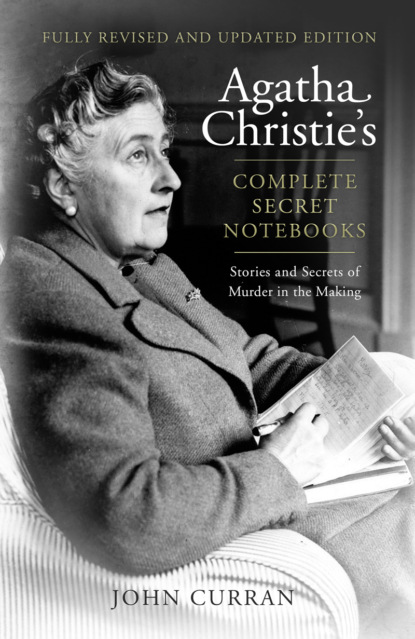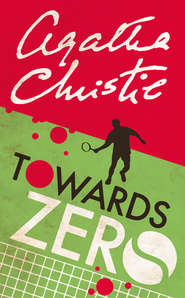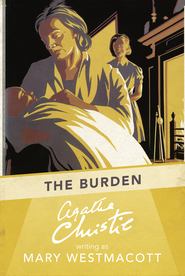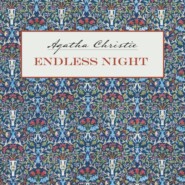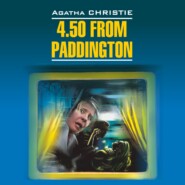По всем вопросам обращайтесь на: info@litportal.ru
(©) 2003-2024.
✖
Agatha Christie’s Complete Secret Notebooks
Настройки чтения
Размер шрифта
Высота строк
Поля
4 (#ulink_b35f3820-597a-543b-af1e-a032581d233d)
Rule of Three (#ulink_b35f3820-597a-543b-af1e-a032581d233d)
‘One of the pleasures in writing detective stories is that there are so many types to choose from: the light-hearted thriller … the intricate detective story … and what I can only describe as the detective story that has a kind of passion behind it …’
An Autobiography
SOLUTIONS REVEALED
The ABC Murders • After the Funeral • Appointment with Death • The Body in the Library • Curtain: Poirot’s Last Case • Death in the Clouds • Death on the Nile • Endless Night • Evil under the Sun • 4.50 from Paddington • Hercule Poirot’s Christmas • The Hollow • Lord Edgware Dies • The Man in the Brown Suit; • ‘The Man in the Mist’ • ‘The Market Basing Mystery’ • The Mousetrap • The Murder at the Vicarage • ‘Murder in the Mews’ • The Murder of Roger Ackroyd • Murder on the Orient Express • The Mysterious Affair at Styles • One, Two, Buckle my Shoe • Ordeal by Innocence • A Pocket Full of Rye • Sparkling Cyanide • Taken at the Flood • They Came to Baghdad • They Do It with Mirrors • Three Act Tragedy • ‘The Unbreakable Alibi’ • ‘The Witness for the Prosecution’
‘Surely you won’t let Agatha Christie fool you again. That would be “again” – wouldn’t it?’ Thus read the advertisement, at the back of many of her early Crime Club books, announcing recent and forthcoming titles from the Queen of Crime. The first Crime Club novel bearing the now-famous hooded gunman logo, was Philip MacDonald’s The Noose in May 1930; Agatha Christie’s first Crime Club title, The Murder at the Vicarage, followed in October of that year. By then Collins had already published, between 1926 and 1929, five Christie titles – The Murder of Roger Ackroyd, The Big Four, The Mystery of the Blue Train, The Seven Dials Mystery and Partners in Crime – in their general fiction list. As soon as The Crime Club was founded, her’s was an obvious name to include and over the next half century she proved to be one of the most prolific authors – and by far the most successful – to appear under its imprint. This author/publisher relationship continued for the rest of her writing life, almost all of her titles appearing with the accompaniment of the hooded gunman.
As the dustjacket on the first edition of The Murder at the Vicarage states, ‘The Crime Club has been formed so that all interested in Detective Fiction may, at NO COST TO THEMSELVES, be kept advised of the best new Detective Novels before they are published.’ By 1932 and Peril at End House, The Crime Club was boasting that ‘Over 25,000 have joined already. The list includes doctors, clergymen, lawyers, University Dons, civil servants, business men; it includes two millionaires, three world-famous statesmen, thirty-two knights, eleven peers of the realm, two princes of royal blood and one princess.’
This is the first edition title page of The Murder at the Vicarage, the first Agatha Christie title to appear under The Crime Club imprint on 13th October 1930.
And the advertisement on the first edition wrapper of The ABC Murders (1936) clearly states the Club’s aims and objectives:
The object of the Crime Club is to provide that vast section of the British Public which likes a good detective story with a continual supply of first-class books by the finest writers of detective fiction. The Panel of five experts selects the good and eliminates the bad, and ensures that every book published under the Crime Club mark is a clean and intriguing example of this class of literature. Crime Club books are not mere thrillers. They are restricted to works in which there is a definite crime problem, an honest detective process, with a credible and logical solution. Members of the Crime Club receive the Crime Club News issued at intervals.
As this suggests, not for nothing was the 1930s known as the Golden Age of detective fiction, an era during which the creation and enjoyment of a detective story was a serious business for reader, writer and publisher. All three took the elaborate conventions seriously. The civilised outrage that followed the publication of The Murder of Roger Ackroyd in 1926 showed what a serious breach of the rules its solution was considered at the time. So, while in many ways observing the so-called ‘rules’, and consolidating the image of a safe, cosy and comforting type of fiction, Agatha Christie also constantly challenged those ‘rules’ and, by regularly and mischievously tweaking, bending, and breaking them, subverted the expectations of her readers and critics. She was both the mould creator and mould breaker, who delighted in effectively saying to her fans, ‘Here is the comforting read that you expect when you pick up my new book but because I respect your intelligence and my own professionalism, I intend to fool you.’
But how did she fool her readers while at the same time retaining her vice-like grip on their admiration and loyalty? In order to understand how she managed this feat it is necessary to take a closer look at ‘The Rules’.
THE RULES OF DETECTIVE FICTION – POE, KNOX, VAN DINE
Edgar Allan Poe: inventor of the detective story
In April 1841 the American periodical Graham’s Magazine published Edgar Allan Poe’s ‘The Murders in the Rue Morgue’ and introduced a new literary form, the detective story. The unwritten ground-rules that distinguish detective fiction from other forms of crime writing – the thriller, the suspense story, the mystery story – were established in five Poe short stories. He pioneered:
The brilliant amateur detective
The less-than-brilliant narrator-friend
The wrongly suspected person
The sealed room
The unexpected solution
The ‘armchair detective’ and the application of pure reasoning
The interpretation of a code
The trail of false clues laid by the murderer
The unmasking of the least likely suspect
Psychological deduction
The most obvious solution
All of Poe’s pioneering initiatives were exploited by subsequent generations of crime writers and although many of those writers introduced variations on, and combinations of, them, no other writer ever established so many influential concepts. Christie, as we shall see, exploited them to the full.
The first, and most important, of the Poe stories, ‘The Murders in the Rue Morgue’, incorporated the first five ideas above. The murder of a mother and daughter in a room locked from the inside is investigated by Chevalier C. Auguste Dupin, who, by logical deduction, arrives at a most unexpected solution, thereby proving the innocence of an arrested man; the story is narrated by his unnamed associate.
Although Poe is not one of the writers she mentions in An Autobiography as being an influence, Agatha Christie took his template of a murder and its investigation when she began to write The Mysterious Affair at Styles, 75 years later.
The brilliant amateur detective
If we take ‘amateur’ to mean someone outside the official police force, then Hercule Poirot is the pre-eminent example. With the creation of Miss Marple, Christie remains the only writer to create two famous detective figures. Although not as well known, the characters Tommy and Tuppence, Parker Pyne, Mr Satterthwaite and Mr Quin also come into this category.
The less-than-brilliant narrator-friend
Poirot’s early chronicler, Captain Arthur Hastings, appeared in nine novels (if we include the 1927 episodic novel The Big Four) and 26 short stories. After Dumb Witness in 1937, Christie dispensed with his services, though she allowed him a nostalgic swan song in Curtain, published in 1975. But she also experimented with other narrators, often with dramatic results: The Man in the Brown Suit, The Murder of Roger Ackroyd, Endless Night. The decision to send Hastings to Argentina may have had less to do with his mental ability than with the restrictions he imposed on his creator: his narration meant that only events at which he was present could be recounted. Signs of this growing unease can be seen in the use of third-person narrative at the beginning of Dumb Witness and intermittently throughout The ABC Murders, published the year before Hastings’ banishment. Miss Marple has no permanent Hastings-like companion.
The wrongly suspected person
This is the basis of some of Christie’s finest titles, among them the novels Five Little Pigs, Sad Cypress, Mrs McGinty’s Dead and Ordeal by Innocence, and the short story ‘The Witness for the Prosecution’. The wrongly suspected may be still on trial as in Sad Cypress or already convicted as in Mrs McGinty’s Dead. In more extreme cases – Five Little Pigs, Ordeal by Innocence – they have already paid the ultimate price, although in each case ill-health, rather than the hangman, is the cause of death. And being Agatha Christie, she also played a variation on this theme in ‘The Witness for the Prosecution’ when the accused suspect is shown to be the guilty party after all.
The sealed room
The fascination with this ploy lies in the seeming impossibility of the crime. Not only has the detective – and the reader – to work out ‘Who’ but also ‘How’. The crime may be committed in a room with all the doors and windows locked from the inside, making the murderer’s escape seemingly impossible; or in a room that is under constant observation; or the corpse may be discovered in a garden of unmarked snow or on a beach of unmarked sand. Although this was not a favourite Christie ploy she experimented with it on a few occasions, but in each case – Murder in Mesopotamia, Hercule Poirot’s Christmas, ‘Dead Man’s Mirror’, ‘The Dream’ – the sealed-room element was merely an aspect of the story and not its main focus.
The unexpected solution
Throughout her career this was the perennial province of Agatha Christie and the novels Murder on the Orient Express, Endless Night and And Then There Were None, as well as the short story ‘The Witness for the Prosecution’, are the more dramatic examples. But mere unexpectedness is not sufficient; it must be fairly clued and prepared. The unmasking of, for example, the under-housemaid’s wheelchair-bound cousin from Australia, of whom the reader has never heard, may be unexpected but it is hardly fair. The unexpected murderer is dealt with below.
The ‘armchair detective’ and pure reasoning
In 1842, Poe’s story ‘The Mystery of Marie Roget’ was an example both of ‘faction’, the fictionalisation of a true event, and of ‘armchair detection’, an exercise in pure reasoning. Although set in Paris, the story is actually an account, complete with newspaper reports, of the murder, in New York some years earlier, of Mary Cecilia Rogers. In this story Dupin seeks to arrive at a solution based on close examination of newspaper reports of the relevant facts, without visiting the scene of the crime. The clearest equivalent in Christie is The Thirteen Problems, the collection in which a group of friends, including Miss Marple, meets regularly to solve a series of mysteries including murder, robbery, forgery and smuggling. Miss Marple also solves the murders in The Mirror Crack’d from Side to Side basing her solution on the observations of others, and visiting the scene of the crime only at the conclusion of the book. She undertakes a similar challenge in 4.50 from Paddington when Lucy Eyelesbarrow acts as her eyes and ears. Poirot solves ‘The Mystery of Hunter’s Lodge’, in Poirot Investigates, without leaving his sick-bed; and in The Clocks, making what amounts to a cameo appearance, he bases his deductions on the reports of Colin Lamb. For the novels of Christie’s most prolific and ingenious period (roughly 1930 to 1950), the application of pure reasoning applies. From the mid 1950s onwards there was a loosening of the form – Destination Unknown, Cat among the Pigeons, The Pale Horse, Endless Night – and she wrote fewer formal detective stories. But as late as 1964 and A Caribbean Mystery she was still defying her readers to interpret a daring and blatant clue.
The interpretation of a code
Poe’s ‘The Gold Bug’, not a Dupin story, appeared in 1843, and could be considered the least important of his contributions to the detective genre. It involves the solution to a cipher in an effort to find a treasure. A variation on this can be found in the Christie short stories ‘The Case of the Missing Will’ and ‘Strange Jest’, both of which involve the interpretation of a deceased person’s last cryptic wishes. Although the code concept was only a minor part of Christie’s output it is the subject of the short story ‘The Four Suspects’ in The Thirteen Problems. On a more elaborate canvas, the interpretation of a code could be seen as the basis of The ABC Murders; and, more literally, it is the starting-point of Christie’s final novel, Postern of Fate.
The trail of false clues laid by the murderer
‘Thou Art the Man’, published in 1844, is not as well known as the other Poe stories but it includes at least two influential concepts: the trail of false clues and the unmasking of the most unlikely suspect. Although a minor theme in many Christie novels, the idea of a murderer leaving a trail of false clues is a major plot device in The ABC Murders and Murder is Easy; and in Towards Zero it is taken to new heights of triple-bluff ingenuity.
The unmasking of the least likely suspect
Like its counterpart above, the unexpected solution, this was a career-long theme for Christie and appears at its most stunning in The Murder of Roger Ackroyd, Hercule Poirot’s Christmas, Crooked House and Curtain. The double-bluff, a regular feature of Christie’s output from her first novel onwards, also comes into this category.
Psychological deduction
Poe’s ‘The Purloined Letter’ pioneered the ideas of psychological deduction and the ‘obvious’ solution. In this type of story, the deductions depend as much on knowledge of the human heart as on interpretation of the physical clues. In Poe’s story Dupin’s psychological interpretation of the suspect allows him to deduce the whereabouts of the eponymous letter. The Foreword to Christie’s Cards on the Table explains that the deductions in that book will be entirely psychological due to the lack of physical clues apart from the bridge scorecards. And Appointment with Death, set in distant Petra, sees Poirot dependent almost entirely on the psychological approach. Five Little Pigs and The Hollow each have similar emotional and psychological content, although both novels also involve physical clues.





